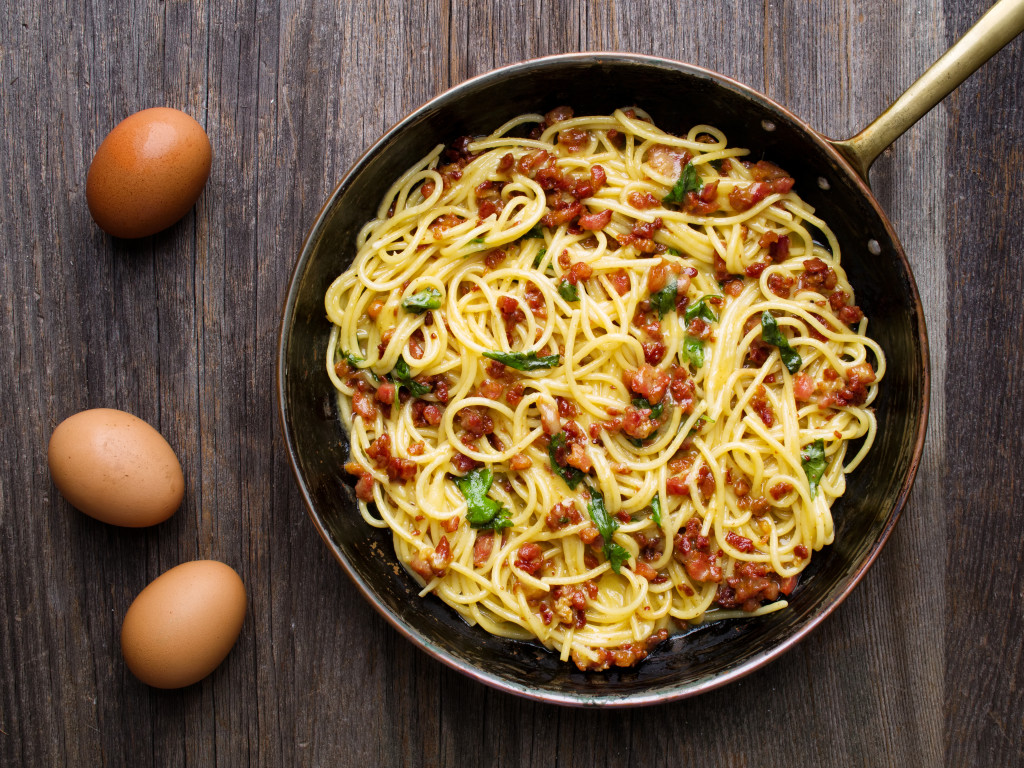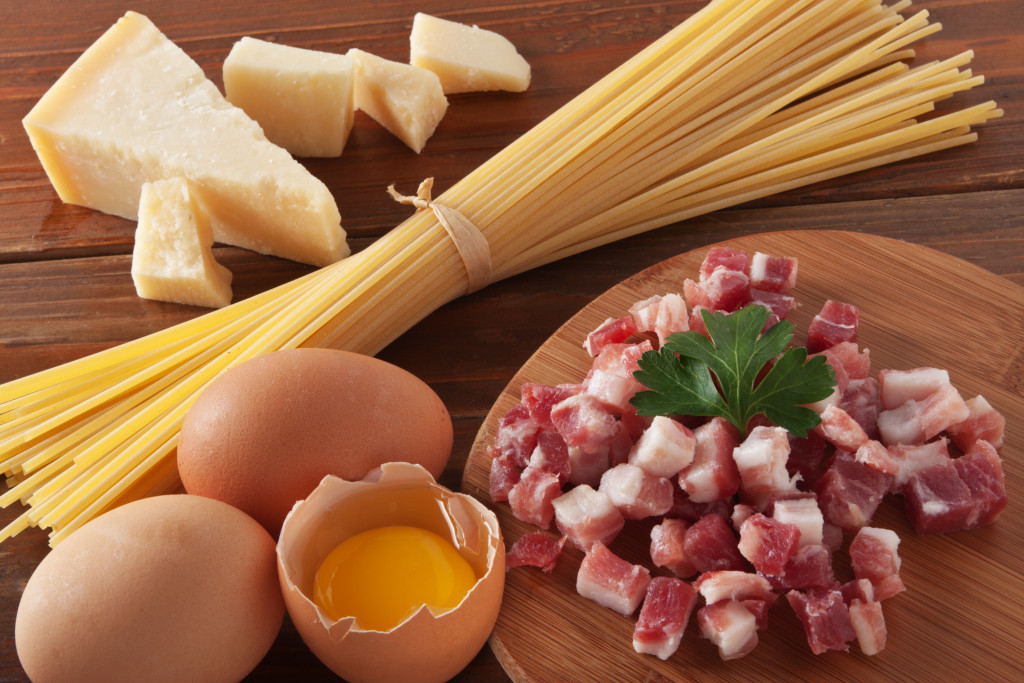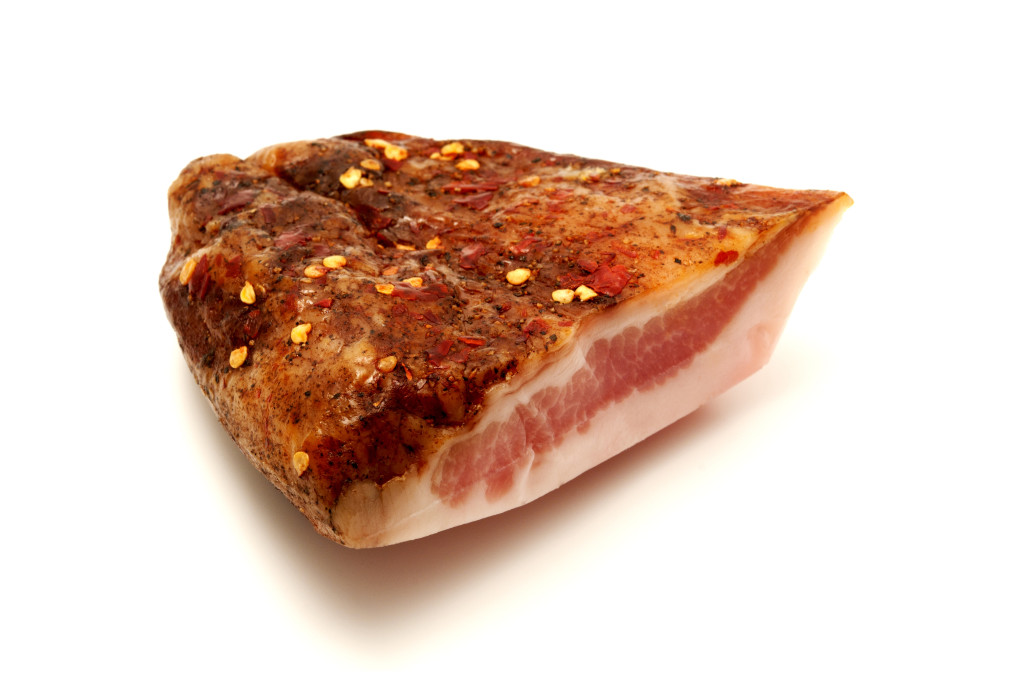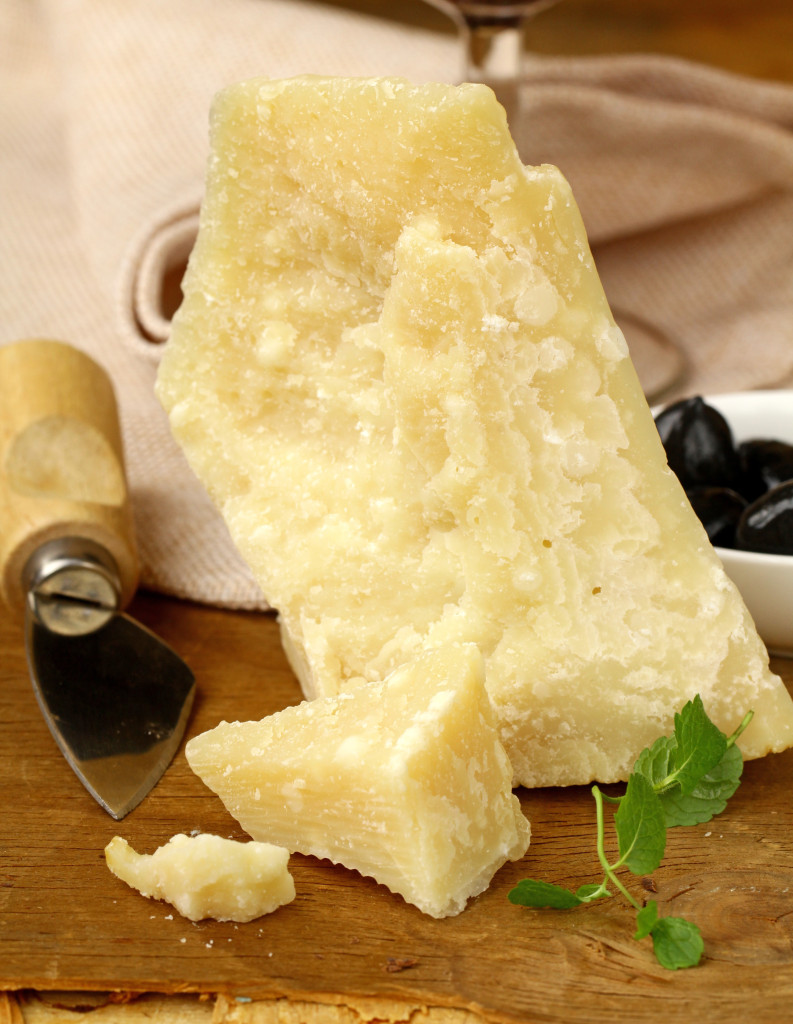How can so many home cooks and restaurants bastardize one of the most fantastic and classic Roman pasta dishes as if it doesn’t matter?
Originally created from pantry staples for a fast, late-night meal, Spaghetti alla Carbonara is so sorely misinterpreted. It is difficult to find the real thing unless you make it yourself.

Let’s get it straight: Authentic Spaghetti alla Carbonara has no cream, no mushrooms, no peas, and no onions or scallions. Okay, it might have bacon or pancetta if you can’t find the authentic guanciale.
Mind you, a pasta dish that includes any or all of the above ingredients may be absolutely delicious—it just isn’t real Spaghetti alla Carbonara.
Origins
The actual origins of the dish are unclear. Some say it was created by sheepherders near Rome because it was made of simple ingredients that shepherds would have as they tended their flocks. Others contend that is was named for coal miners, stemming from the word carbonaro, which means charcoal burner. And finally, some believe it was created around the time of World War II when Italians had an abundance of U.S.-rationed eggs and bacon.
The Ingredients
True carbonara is a simple dish of only a few ingredients. Eggs, cheese, and three P’s: pork, pasta, and pepper. That’s it.

So let’s deconstruct authentic carbonara, head into the kitchen, make a big bunch of it, then chow down to your heart’s content in pasta heaven. A crisp, chilled white would be an excellent complement. An arugula salad with a light vinaigrette would complement and cut through the richness of the dish to round out a magnificent repast.
Spaghetti
If you can find true, imported Italian spaghetti from an artisanal manufacturer, you will never go back to the mass-produced, supermarket variety. It is an eye-opening eating experience with more sauce-hugging texture and flavor than any pasta you’ve consumed previously, with the possible exception of homemade pasta. The small-production pastas are most likely made using age-old milling and production tools, such as hand-carved bronze dies, that give them a rustic surface texture that is worlds away from the smoothness of product made with modern machining. Garofalo, which traces its history to 1789; Rustichella d’Abruzzo; and Benedetto Cavalieri are excellent brands in the artisanal category.
Pepper
Don’t use the pre-ground stuff in a tin box. You might as well use sawdust. Grind it or crush it fresh yourself. If you are new to this, you will not believe the intensity of flavor and aroma of freshly ground pepper. You will thank us later. A good-quality Malabar or Tellicherry are excellent. But, if you want the ultimate, try Parameswaran’s Wynad pepper from the Kerala region of India.
Pork
This is where things get dicey—literally. The original carbonara recipe calls for guanciale—cured hog jowl and cheek, cut into 1/4-inch cubes. Guanciale is similar to pancetta—uncured Italian bacon—but is fattier with a bolder pork flavor.

As a practical matter, guanciale is not something you’ll find in the typical deli case. So short of getting an online source, you may have to consider acceptable alternatives.
Therefore, the first choice would be pancetta. Pancetta is a salt-cured pork belly that is rolled and often seasoned with black pepper, which complements the pepper already in the recipe. In recent years, pancetta has become much more readily available and can be found in well-stocked deli cases.
When it comes to bacon as an alternative, you have to go with your instincts. Guanciale and pancetta are cured, but not smoked. As a result, carbonara purists would get a little uncomfortable if we started talking about using any kind of smoked bacon.
However, at risk of heretical suggestion, good hickory- or apple-smoked bacon adds some really good flavor to this dish, especially the way the smoke blends with the pepper and the flavor-rich smoky bacon fat coats the pasta.
Eggs
Not much to be said here, except Grade A large and as fresh as you can get them.
Cheese
Parmigiano-Reggiano and Pecorino Romano. Accept no substitutes. With so few ingredients in carbonara, each one’s quality has to shine. If you don’t use these two cheeses, your carbonara will be a lackluster wannabe.
These two cheeses are similar in that they are both hard, dry Italian grating cheeses.
Romano comes from the hills surrounding Rome and has a bolder flavor—pungent and salty. True Pecorino Romano is made from sheep’s milk, whereas other varieties, including domestic versions, usually are made from cow’s milk which results in a lighter flavor. Pecorino Romano has a higher fat and moisture content and is aged for about 15 months.
Originating in Parma, Italy, Parmigiano has a milder, nutty flavor, is aged for about 10 months, and is always handmade.

In Italy, the name Parmigiano-Reggiano is government-regulated and the word Parmesan is officially identified as being synonymous with Parmigiano-Reggiano. Therefore, any Parmesan-style cheeses must be labeled something other than Parmesan. In the U.S., however, Parmesan can be related to various versions of the original.
If you are interested in how Parmigiano-Reggiano is made, check out this stunningly beautiful video.
For the best flavor, buy a block of each cheese and have it freshly grated for you. Don’t buy pre-grated packaged cheeses. They contain anti-caking chemicals and just will not have the same robust flavors of the Reggiano and Pecorino. Also, these chemicals prevent the cheese from incorporating smoothly into sauces.
Putting it all Together
Who better to guide us through making authentic Spaghetti alla Carbonara than the Italian cooking stallion himself, Mario Batali. Check out his definitive recipe here.
Have you ever had authentic Spaghetti alla Carbonara? How much of a purist are you about carbonara? Do you prefer it with cream, peas, and other additions?



Leave Your Response